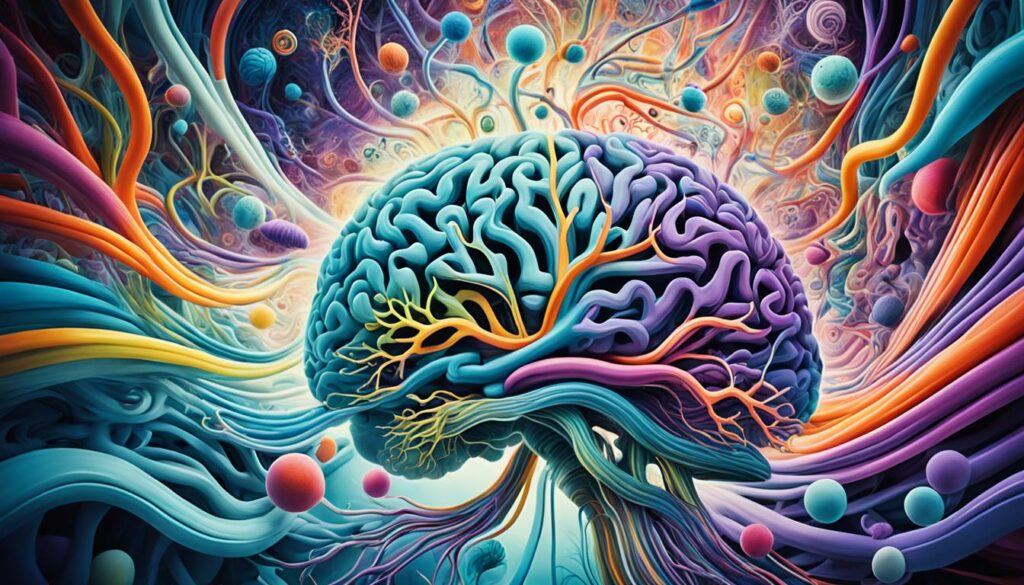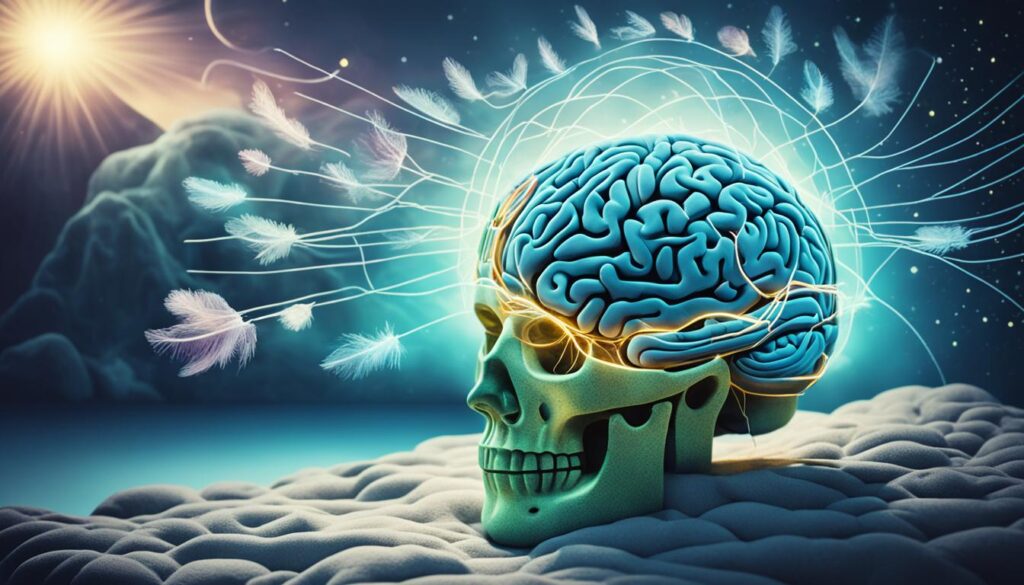Have you ever woken up from a dream, feeling your heart race? Imagine controlling that dream. That’s what lucid dreaming is all about. It lets you be the boss of your dreams. This is real and can change your mental health for the better.
About half of people have had a lucid dream at some point1. It’s when you know you’re dreaming and can change the dream. This skill is great for mental health and growing as a person.
Lucid dreaming helps with problem-solving, facing fears, and healing emotions1. It’s not just fun; it’s a way to improve your life. Imagine tackling your fears or solving problems in a dream world.
Lucid dreaming is good for your mental health. It can make you feel better when you wake up and may help with anxiety and depression1. It’s like having a therapist in your sleep, helping you work through tough emotions.
Want to try lucid dreaming? With practice and the right methods, you can use it for your mental health. Let’s explore lucid dreaming and see how it can open new doors for your mind.
Key Takeaways
- Lucid dreaming allows awareness and control in dreams
- About 50% of people have experienced lucid dreaming
- It can aid in problem-solving and emotional healing
- Lucid dreaming may improve mood and reduce anxiety
- With practice, anyone can learn lucid dreaming techniques
- It’s a potential tool for enhancing mental health
Understanding Lucid Dreaming: A Window to Consciousness
Lucid dreaming opens a fascinating portal to self-awareness in sleep. This unique state lets you know you’re dreaming while asleep. It gives a rare look into the depths of consciousness.
What is lucid dreaming?
Lucid dreaming happens when you know you’re dreaming while asleep. It’s a state where your mind connects sleep and wakefulness. This lets you control your dreams. About 20% of people have one lucid dream a month, showing it’s quite common2.
The science behind lucid dreaming
Studies show special brain activity in the prefrontal cortex during lucid dreams. This area is linked to knowing yourself and thinking deeply2. These findings reveal the unique brain processes during these dreams.
Researchers found that lucid dreamers have better communication in their brains. This means they are more aware during sleep.

Prevalence and frequency of lucid dreams
Lucid dreaming is popular, shown by online communities. A subreddit for it has over 400,000 members, showing lots of interest3. Young people often have these dreams naturally, but there are ways to make them happen more often.
A study found that taking a certain medicine made people 42% more likely to be aware in their dreams. This was much less in the group that didn’t take the medicine3.
The benefits of lucid dreams go beyond just being interesting. They can help with controlling emotions during sleep. In fact, over 85% of people in a study who had lucid dream therapy were no longer diagnosed with PTSD after six days2.
The Neuroscience of Lucid Dreaming
Lucid dreaming is when you know you’re dreaming while asleep. It’s been studied for years. During these dreams, certain brain areas work together. This lets you control your dreams and boost creativity.
Your brain changes a lot in lucid dreams. The bilateral precuneus lights up, helping you know you’re dreaming. The cuneus makes your dreams look more real.
The prefrontal cortex is also key. It helps you make decisions and control your dreams. This might explain why lucid dreaming can help with anxiety.

Studies say we dream for about two hours each night. Lucid dreaming happens during REM sleep4. This type of sleep is very active, with your body and mind working hard5.
Some research links more lucid dreaming to poor sleep quality. But, it can also have good effects4. For example, it might help people with PTSD feel less anxious and depressed4. Yet, the effects of lucid dreaming on mental health are complex46.
Scientists are using new methods to study lucid dreaming5. They’re looking into how it works and how it can help with mental health.
“Lucid dreaming opens a window into the fascinating world of consciousness, offering unique insights into the workings of our minds during sleep.”
As we learn more, scientists hope to use lucid dreaming for creativity, mental health, and understanding our minds better.
Benefits of Lucid Dreaming for Mental Health
Lucid dreaming lets you see into your mind. It helps with mental health in many ways. You can control your dreams and grow personally.
Overcoming Nightmares and PTSD
Lucid dreaming can help with nightmares and PTSD. You can change your dreams and feel in control. This can stop nightmares7. It also helps people with PTSD feel better8.
Reducing Anxiety and Depression
Lucid dreaming can make you feel less anxious and happier. People who dream lucidly feel less anxious8. It helps you be more confident and positive, which can help with depression.

Enhancing Creativity and Problem-Solving
Lucid dreams boost creativity and problem-solving skills7. You can try new ideas without worry. This can make you more creative and better at making decisions.
Improving Self-Awareness and Emotional Regulation
Lucid dreaming makes you more aware of your thoughts and feelings7. This helps you handle your emotions better. You learn you can change your dreams and experiences by making choices.
| Benefit | Impact |
|---|---|
| Nightmare Reduction | Decreased PTSD symptoms |
| Anxiety Management | Improved mood and reduced stress |
| Enhanced Creativity | Better problem-solving skills |
| Self-Awareness | Improved emotional regulation |
These benefits are best for those who are good at lucid dreaming. Learning how to lucid dream can help you use these benefits. It can make you more aware of yourself while you sleep.
Lucid Dreaming as a Therapeutic Tool
Lucid dreaming is a new way to help with mental health. It lets people control their dreams and manage emotions. This can be a big help for those struggling with sleep and feelings.
Integration with Cognitive Behavioral Therapy
Cognitive Behavioral Therapy (CBT) is now working with lucid dreaming. Together, they help people change their dreams and feel better. This is especially good news for those with PTSD, as it can lessen nightmares and improve sleep.
About 80% of PTSD patients have nightmares that affect their daily life9.
Imagery Rehearsal Therapy for Nightmare Disorders
Imagery Rehearsal Therapy (IRT) helps with bad dreams. When combined with lucid dreaming, it works even better. This mix can lower anxiety and depression in PTSD patients9.

Potential Applications in Physical Rehabilitation
Lucid dreaming can also help with physical therapy. Studies show that practicing in dreams can make waking skills better. A 2015 study found that people who moved in dreams got faster in real life10.
This could be a big help for people who have trouble moving.
| Application | Benefit | Research Finding |
|---|---|---|
| PTSD Treatment | Reduced nightmares | 80% of PTSD patients experience nightmares9 |
| Anxiety Management | Improved emotional regulation | Significant decrease in anxiety levels9 |
| Physical Rehabilitation | Enhanced motor skills | Improved performance speed in waking life10 |
Lucid dreaming looks promising for therapy, but we need more studies. Always talk to a doctor before trying new things for your mental health.
Techniques to Induce Lucid Dreams
Learning how to control your dreams can make them more meaningful. About 55% of adults have had a lucid dream, but only 23% have them every month11. You can try different ways to make lucid dreams happen and boost your creativity.
One way is to check if you’re dreaming all day. This habit can help you become lucid in your dreams. Another good method is the Wake Back to Bed (WBTB) technique, often used with the Mnemonic Induction of Lucid Dreams (MILD)11. WBTB means waking up 5-6 hours after sleeping, which can increase your chance of a lucid dream during REM sleep12.
Keeping a dream journal is key to remembering your dreams and becoming lucid1212. Adding meditation or mindfulness to this can really help you achieve lucidity. Everyone is different, but with practice, you might control your dreams and have better experiences12. These methods can help with creativity and self-awareness, but be careful not to mess up your sleep.
FAQ
What is lucid dreaming?
Lucid dreaming is when you know you’re dreaming and can control your dreams. It happens during REM sleep. It’s like being awake and asleep at the same time.
How prevalent are lucid dreams?
About 20% of people have lucid dreams every month. And 55% have had at least one lucid dream in their life.
What are the potential mental health benefits of lucid dreaming?
Lucid dreaming can help with problem-solving and overcoming fears. It can also help with spiritual growth and emotional healing.
What brain regions are active during lucid dreaming?
Certain brain areas work during lucid dreaming. The bilateral precuneus helps with being aware and remembering things. The cuneus improves seeing things in dreams. The prefrontal cortex helps with making decisions and controlling the dream.
How can lucid dreaming help with PTSD and nightmares?
Lucid dreaming can help with PTSD and nightmares. It lets dreamers control their dreams and face their fears safely.
How is lucid dreaming integrated with cognitive behavioral therapy?
Lucid dreaming is being used as a therapy tool. It’s combined with cognitive behavioral therapy (CBT) and imagery rehearsal therapy (IRT). This helps treat nightmares and PTSD.
What techniques can induce lucid dreams?
There are many ways to induce lucid dreaming. These include reality testing, the Wake Back to Bed (WBTB) method, and keeping a dream journal. The Wake-Initiated Lucid Dream (WILD) technique also works. Using a mix of these methods can be best.
Source Links
- https://www.healthline.com/health/lucid-dreaming-the-latest-on-its-mental-health-benefits-and-risks
- https://pillow.app/article/are-lucid-dreams-real
- https://www.theguardian.com/science/2021/nov/14/can-lucid-dreaming-help-us-understand-consciousness
- https://www.sleepfoundation.org/dreams/dangers-of-lucid-dreaming
- https://www.ncbi.nlm.nih.gov/pmc/articles/PMC6451677/
- https://www.ncbi.nlm.nih.gov/pmc/articles/PMC6993576/
- https://kripalu.org/resources/five-benefits-lucid-dreaming
- https://www.webmd.com/sleep-disorders/lucid-dreams-overview
- https://www.ncbi.nlm.nih.gov/pmc/articles/PMC7471655/
- https://www.sleepcycle.com/how-to-fall-asleep/sleep-dream-and-boost-your-creativity/
- https://www.sleepfoundation.org/dreams/lucid-dreams
- https://www.medicalnewstoday.com/articles/323077



